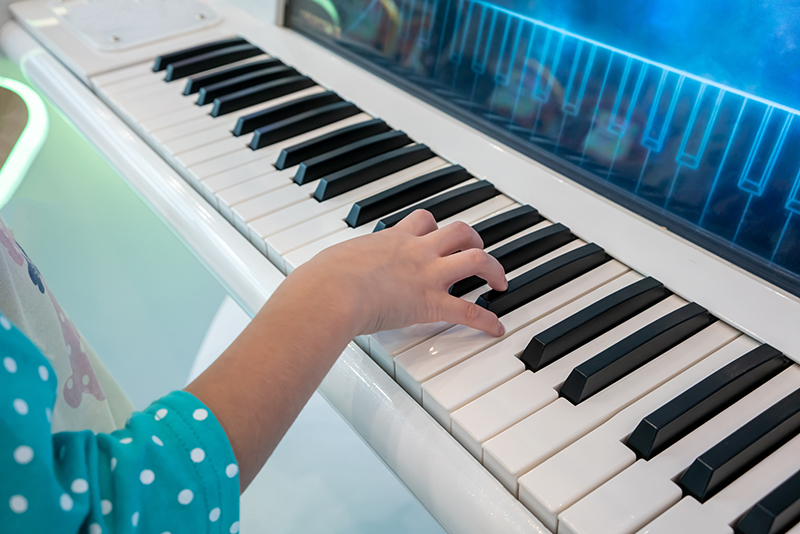During the research and development of the Numeric Language of Music program, I received a call from a woman asking me to enroll her granddaughter in the program. She described her granddaughter as having a significant attention deficit disorder. The girl had difficulty reading, and would not participate in class reading aloud. Also, the girl avoided physical contact with people, even with her grandmother. Instead of hugging, she would bump her lightly with her elbow. We agreed upon five sessions in the program, one each week.
Upon arrival at their home, I talked with the grandmother for almost 30 minutes while her granddaughter ran in and out of the house. I explained to the grandmother the importance of not pressuring the girl to practice the piano lesson between sessions. The child finally calmed down enough to sit next to me at the piano.
As I began the session, I noticed the girl’s fingers on both hands arched upward from the keys. It was an effort for her to make each finger curve down to play the key I asked her to play. Quickly, however, she had a fundamental idea of how the pattern of structural form and motion was arranged. The first numeric sequence I introduced moved the pattern in sequential order from left to right. The session lasted about 20 minutes when the girl reached her capacity of attention.
Two days before the second session, the grandmother called me rather upset. No matter how many times she told her granddaughter she needed to practice, the girl refused. I reminded her of the importance of not pressuring her. I explained the program did not require practice to be effective.
Upon arriving for the second session, I waited while the girl finished playing with her horse outside. Multiple times she would come running in the house with a smile and then run right out again. Thirty minutes minutes later, she said she was ready for her piano lesson.
As she sat down at the piano, she proceeded to play the patterns of structural form and motion perfectly. Her fingers gently relaxed on the piano keys. Her performance was fluent, as though she practiced at least an hour a day. She played the pattern through the simple numeric sequence moving from left to right.
I began the second session introducing a more complicated numeric sequence. I assisted by pointing to the numeric location from which the pattern was to be performed. After repeating the exercise several times, she pushed my hand away playing the performance through the numeric sequence several times without assistance. I introduced her to a second pattern of structural form and motion. Once she mastered the physical dexterity of the pattern, I told her she could play the new pattern through either sequence. I ended the session without asking her to combine the new pattern of structural form and numeric sequence in front of me. The second session lasted approximately 30 minutes.
I arrived for the third session at the usual time. As I entered the door, the girl ran across the room in my direction and threw herself into my arms wrapping her arms around my neck, her legs around my waist hugging me in full body contact. The grandmother did not know what to say.
Each session from that day forward, the grandmother told me about amazing changes in her granddaughter. Previously she said, the girl’s behavior was very difficult. She would not help around the house. She was mean spirited and rude, always back talking her. Since the sessions began, the girl’s behavior changed. She was happy to help her grandmother do the dishes, carry groceries. She was polite, even asking for permission to leave the table. She was cooperating with what her grand- mother asked her to do.
The last session I had with her was amazing. She sat at the piano playing the pattern of structural form and motion flawlessly through the most complicated numeric sequence she had learned. At the same time she played, she began a conversation with me describing each ingredient and how much of each ingredient she had used to make an apple pie for her grandmother.
The grandmother told me the night before the last session, her granddaughter went into her room, selected a more difficult book for her age, returned to the living room and read the book aloud for her.

